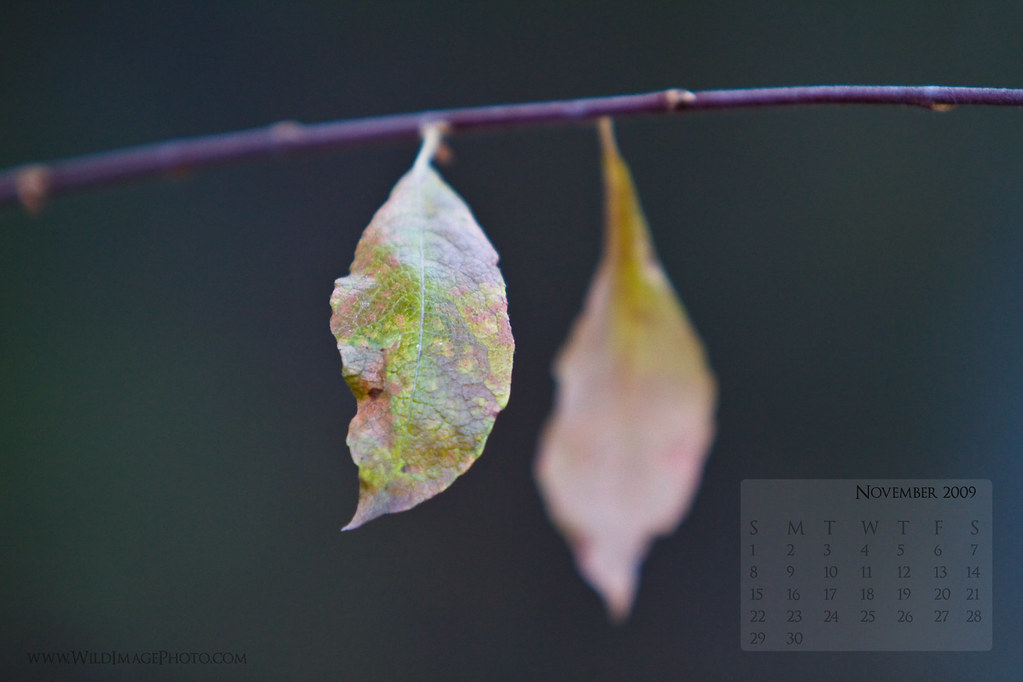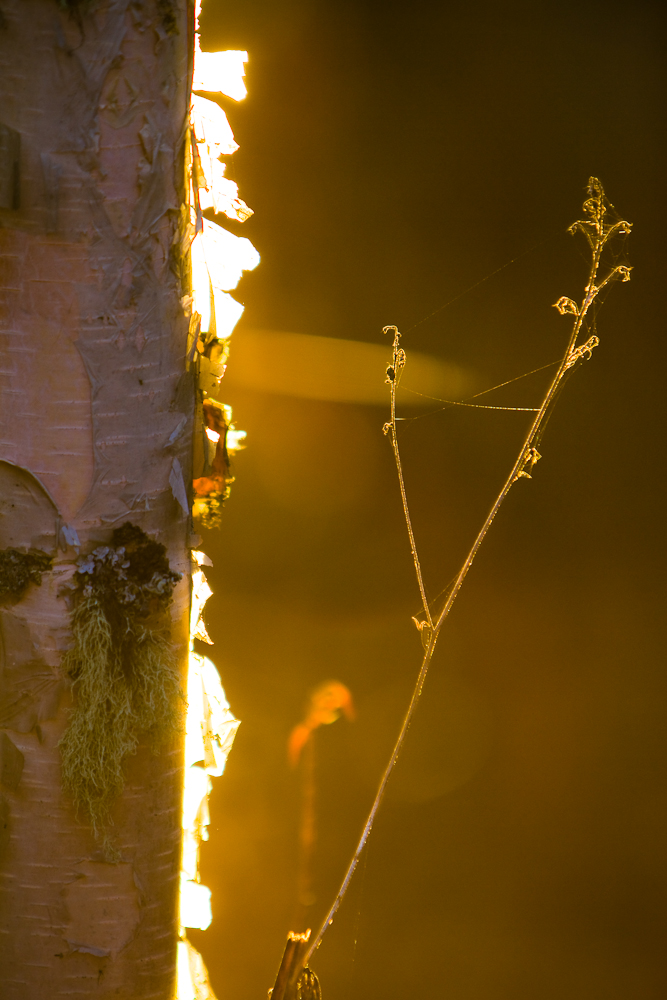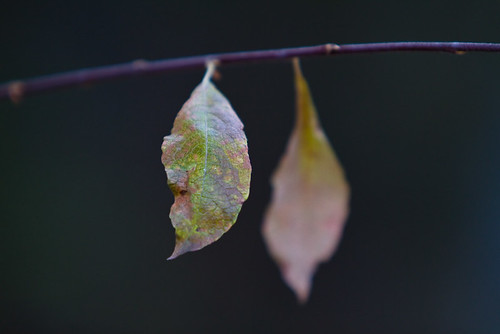Friday, October 30, 2009
Wilderness Photography
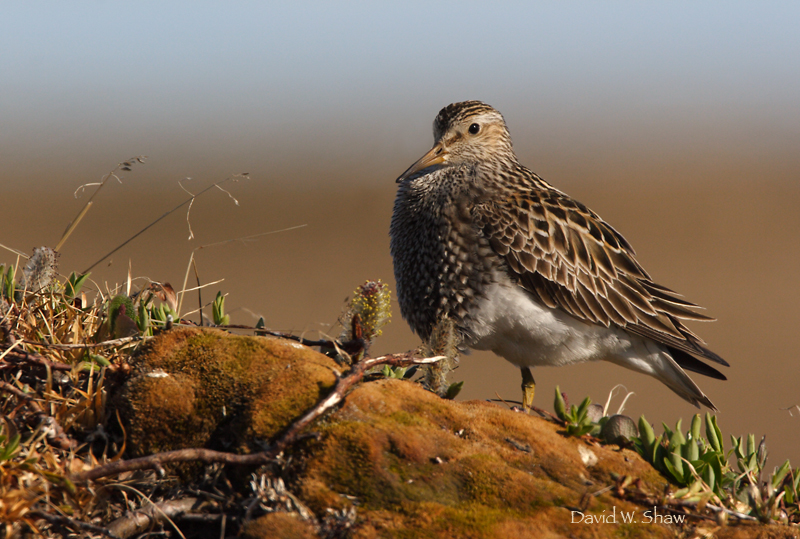
Canon 20D, 500mm f4L w/ 1.4tc, 1/800th sec @ f10, ISO 200
I made the image above on a photography trip I was leading for the excellent wilderness outfitter Arctic Wild in 2007. It was a custom trip, which basically means that the two clients wanted to have a trip designed to their needs. I was fortunate enough to be their guide. In mid-June I met my two clients in the remote village of Kaktovik on the coastal plain of the Arctic National Wildlife Refuge. From there we flew out to a wilderness airstrip on the Canning River for a few days of shooting, then moved north to the mouth of the Canning for the final days of the trip. Bird photography was the goal of the trip, and I did my best to put the two clients in the best situations I could muster. I think I was fairly successful. But shooting in these areas is not easy. There are a lot of considerations from memory cards to charging batteries, to packing light for small-plane travel. I regularly get questions about what I carry on a wilderness photography trip, and here is my answer:
I take what I need. There now we can all go home.
Of course it isn't that straightforward. Needs and wants are often confounded so its important to understand priorities. First and foremost, I carry what I need to stay warm, dry, and well-fed. It is impossible to take good photographs, if my hands are too cold to hold the camera because I decided to leave behind my mittens in exchange for an extra lens. I won't go into the details of my personal packing list, because it varies so much from trip to trip. From there I can start thinking about camera gear.
On most flights into the bush, passengers are limited to 50-60lbs of personal gear. On backpacking trips that amount will also include your share of the food and group equipment. So packing light is key. I can generally get all my non-photographic equipment including tent, clothing, sleeping bag, pad and such down to 25-30lbs. That leaves 25-35 lbs remaining for camera gear. Here is my photo equipment list for a non-backpacking, photography specific trip:
2 camera bodies (a backup is vital)
500mm f4
1.4x TC
17-40 f4
70-200 f2.8
30mm f1.4 (this one is optional, and can be left behind if things are tight)
Carbon fiber tripod
Memory card wallet with about 25 gigs of memory
Camera backpack
2-3 extra batteries
Solar panel and battery charger
2 stand-alone battery powered hard drive/card readers
Small bag of filters, remote triggers and other accessories
Total camera gear weight: about 30lbs.
Backing up images is vital. A good friend and fellow Alaska photographer, Hugh Rose, recently lost his compact flash card wallet overboard in Prince William Sound. I'm not sure he had his images backed up or not, but the lesson is clear: cards are replaceable, but your images aren't, so backup. Several companies make external, stand-alone, battery-powered hard drives that can be used to back up your images no matter where you are. Jobo, Sanho, Nexto, and Epson are four. I carry two in separate waterproof cases so everything is in duplicate.
Battery charging- With some luck, your time in the backcountry will include a few sunny days and the sun is an excellent source of electricity if you've got the right tools. Brunton manufactures several varieties of compact and foldable solar panels. With the right attachments and chargers, you have all you need to keep shooting. I won't go into the technical details here, but check out their website for some ideas. You can purchase chargers made to work with a variety of camera batteries (using adjustable contact points on the charger) which are compatible with solar panels. A visit to your local battery supply store will get you going in the right direction.
So the summary is this: extended photo trips to the world's wild places can be full of hurdles. But none of them are insurmountable. If you have more questions about this, or anything else, leave them in the comments and I'll do my best to answer them.
Thursday, October 29, 2009
Winter Afternoon
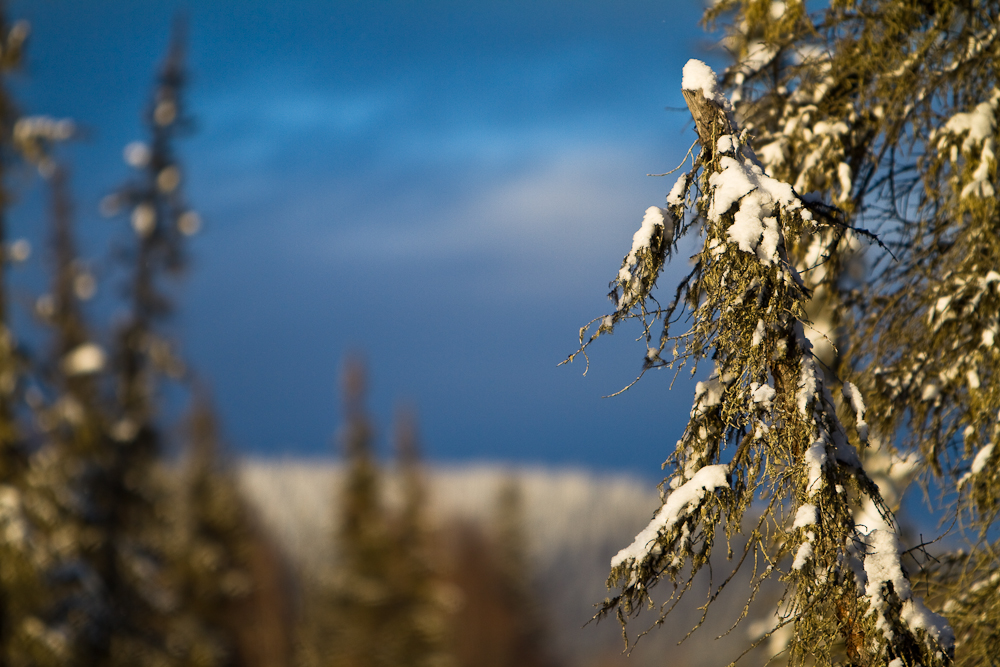
Canon 7D, 70-200 f2.8L IS @ 200mm, 1/1600th at f2.8, ISO 100
I'm afraid I'm not feeling inspired today for blogging, but here is an image from this afternoon. The last of the clouds from the past days snow blew away in the night and we were graced with a beautiful sunny day. I got away from the computer for an hour or so to take a walk with my camera. Nothing earth shattering, I'm afraid, but I like the depth of this image.
I got an email today asking about what equipment to take on a wilderness photography trip next summer. It seemed like a good topic for a blog post since I imagine a lot of you may have the same question. Look for that tomorrow.
I got an email today asking about what equipment to take on a wilderness photography trip next summer. It seemed like a good topic for a blog post since I imagine a lot of you may have the same question. Look for that tomorrow.
Wednesday, October 28, 2009
Yard Moose
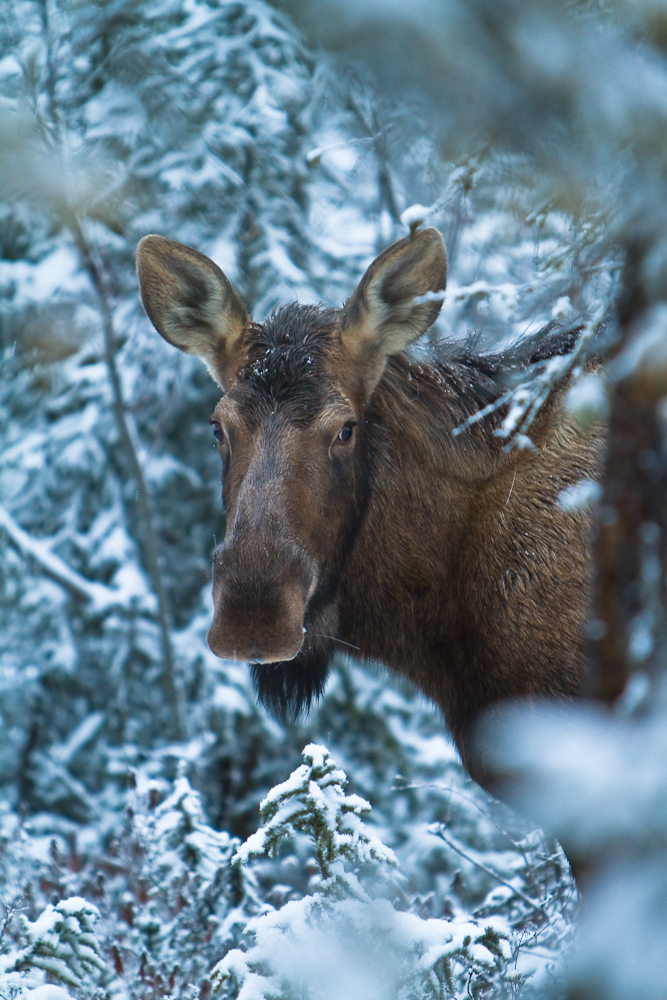
Canon 7D, 70-200f2.8L IS @ 200mm, handheld, 1/40th, f2.8, ISO 800.
It even looks like winter now. Over the past couple of days 4 or 5 inches of snow have fallen and more is coming down outside as I type this. With winter comes some difficulties, the roads get nasty, my driveway becomes an utter disaster, but it is also remarkably beautiful. The spruces become coated with a thick layer of snow, and things start to look, well, Christmasy... In Fairbanks and much of Alaska, the stereotype of Christmas is the reality for much of the long winter. That stasis makes the beauty hard to appreciate, so it is the seasons of change, like right now, when I am most enthralled.
I photographed this moose on my property this morning. I live on ten acres and through the lower section of the property a small creek flows (or ices over depending on the season). The valley is used as a corridor for all kinds of animals. There were fox tracks all over the driveway this morning and a pair of moose tracks as well. They were fresh, and sure enough, as I was heading out, there they were, two cow moose, grazing unconcernedly on the willows. I grabbed my camera and made a few images. The light was just getting bright enough and the moose were cooperative, even with the 70-200 I was able to easily get frame-filling images. I like this image the best because it says something about the animal. Moose spend a lot of time in dense brush, and despite their enormous size (1000lbs or more) they often seem invisible. Trying to portray that, and still get a tight shot, I framed through a window of spruce boughs. This is not an image I thought long and hard about, but I know a bit about moose and the decision for how to compose was an easy one. I have some other frames from the morning I'll try to post in the next few days to show some alternatives. Wildlife photography happens on the fly and knowing something about the subject before you start shooting will help you work more quickly and with better results.
I photographed this moose on my property this morning. I live on ten acres and through the lower section of the property a small creek flows (or ices over depending on the season). The valley is used as a corridor for all kinds of animals. There were fox tracks all over the driveway this morning and a pair of moose tracks as well. They were fresh, and sure enough, as I was heading out, there they were, two cow moose, grazing unconcernedly on the willows. I grabbed my camera and made a few images. The light was just getting bright enough and the moose were cooperative, even with the 70-200 I was able to easily get frame-filling images. I like this image the best because it says something about the animal. Moose spend a lot of time in dense brush, and despite their enormous size (1000lbs or more) they often seem invisible. Trying to portray that, and still get a tight shot, I framed through a window of spruce boughs. This is not an image I thought long and hard about, but I know a bit about moose and the decision for how to compose was an easy one. I have some other frames from the morning I'll try to post in the next few days to show some alternatives. Wildlife photography happens on the fly and knowing something about the subject before you start shooting will help you work more quickly and with better results.
Tuesday, October 27, 2009
There is No Bad Light
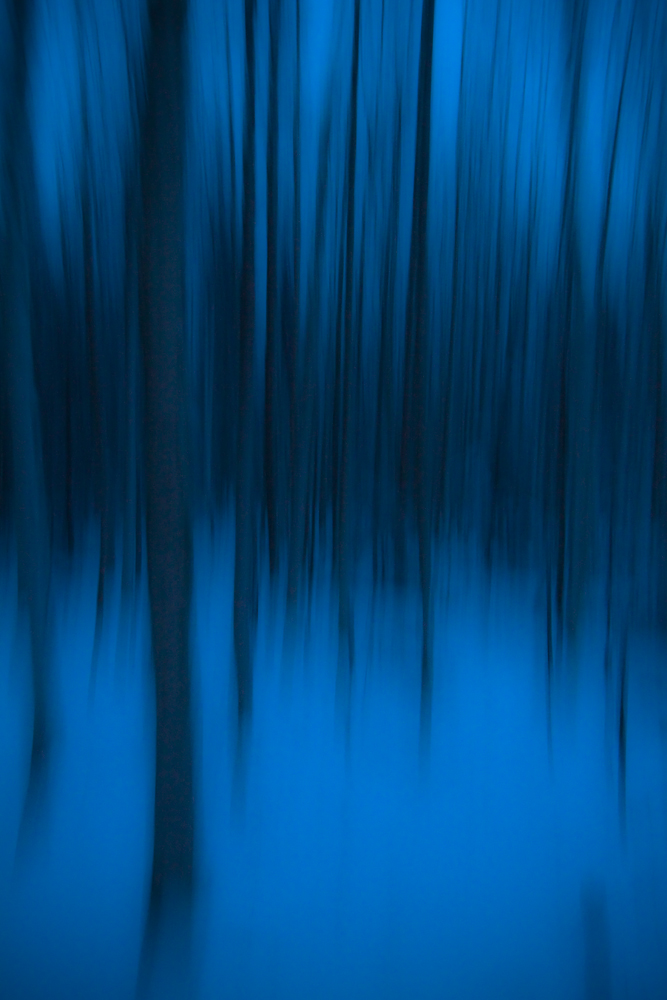
Canon 7D, 17-40L @ 17mm, 1/4 sec, f4, ISO 800, -1.0 stop exposure conpensation, vertical pan blur.
Well that isn't entirely true. Some light is easier to work with than others. You aren't going to get a beautiful landscape image in harsh mid-day sunshine. You just aren't. Sorry. But move into a grove of trees where things are shaded and suddenly you have nice diffused light for making portraits, flower shots, and such.
This morning however, was a challenge. I was walking home after dropping my truck off at the mechanic. It was about 8:30, snowing lightly and only the dim, blue, pre-dawn light was filtering through the flakes and clouds. In short, it was nearly dark. So how do you work with this? There are a number of ways. You could mount a tripod use a long exposure on a low ISO to keep the noise down and hope for the best. But likely the best, using that technique, would be a very blue looking snowy-forest. Not ideal. I was trying to work with how the scene felt to me. Early light here is very blue, I'm cool with that, so I let the camera go to blue without adjusting white balance to compensate. The forests of birches I was walking through always seem very surreal this time of day, kind of spooky even, all blues and whites. I didn't have a tripod, just my 7D and 17-40 f4L lens. So I created blurs. Zoom blurs, vertical and horizontal pan blurs. I jiggled the camera, shook it and spun around as fast as I could to see what kind of image I'd get. This is my favorite. It is a vertical pan blur and I think, in a very abstract way it represents the look of the boreal forest early on winter morning. I also like the way the dark middle almost makes the top and bottom appear like reflections, or a Rorschach test. It takes a moment to grasp what you are looking at, and I like that.
Even bad light has potential if you use it the right way.
Monday, October 26, 2009
Return of the Winter Birds
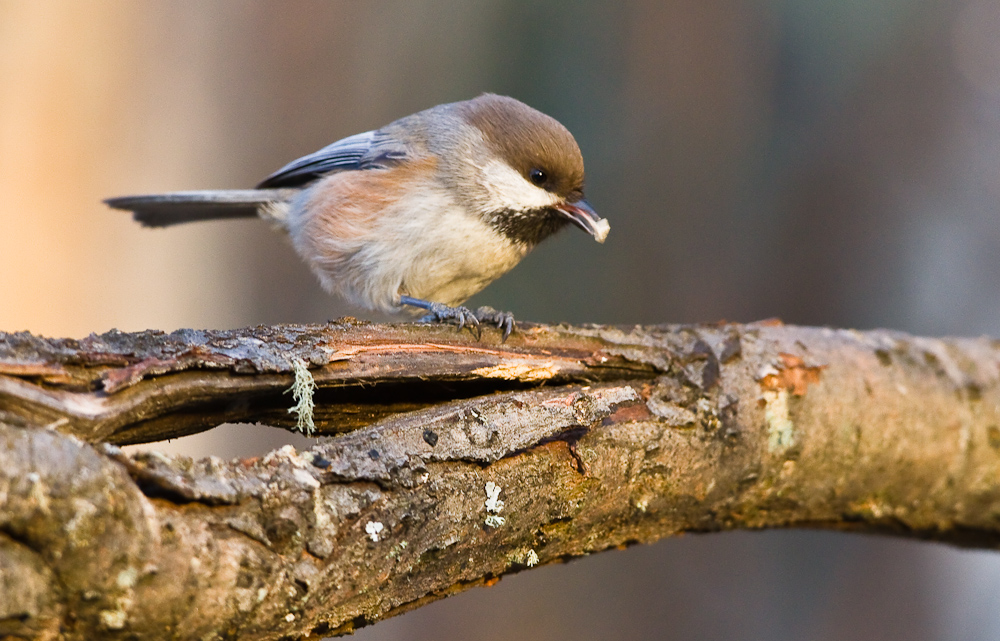
Canon 7D, 500mm f4L IS, Tripod mounted, 1/80th @ f5.6, ISO 800.
I mentioned a few days back how, now that winter is arriving, the light is long and sweet for most of the daylight hours. Well its true, but in exchange, we have many fewer hours of light. In fact today we declined down to 8 hours and 28 minutes of possible sunlight, a loss of about 6 and half minutes over yesterday. But that is all beside the point. Yesterday I took advantage of the last hour of daylight to shoot the birds around our feeders. I've been trying for awhile to get a really excellent image of a Boreal Chickadee, but I still haven't attained it. The one above is fine, but not much more than that. Getting the perfect image takes a lot of time and effort, and I'll be working on this one for awhile. I think part of the problem is that I'm having a hard time visualizing exactly what I want from the image. This part of the creative process of photography that is most difficult for me. Determining what I want before I go out and try to get it. It is best to have some idea of the story you want to tell. In this case, I want to say something about the bird, its natural history and habitat, its ability to survive the cold. The image above does none of those things. Rather is a simple portrait, eating a sunflower seed no less. Hardly a natural food source here in Fairbanks.
My point in all this rambling is to think about your photos before you go out and try to make them. Ask yourself what story you want to tell and then think hard about what image will tell that story, then work to make the image. I'm still struggling with this myself.
My point in all this rambling is to think about your photos before you go out and try to make them. Ask yourself what story you want to tell and then think hard about what image will tell that story, then work to make the image. I'm still struggling with this myself.
Saturday, October 24, 2009
A great image by Danny Green
 Image by Danny Green
Image by Danny GreenI just had to share this image from this year's Veolia Environment Wildlife Photographer of the Year competition. This image is by Danny Green, and I absolutely love it. Great use of a long exposure to capture the wave of a huge starling flock passing over the trees. Motion, mass and volume all represented. Very cool indeed. You can check out the rest of the winning images here.
Friday, October 23, 2009
Canon 7D- thoughts
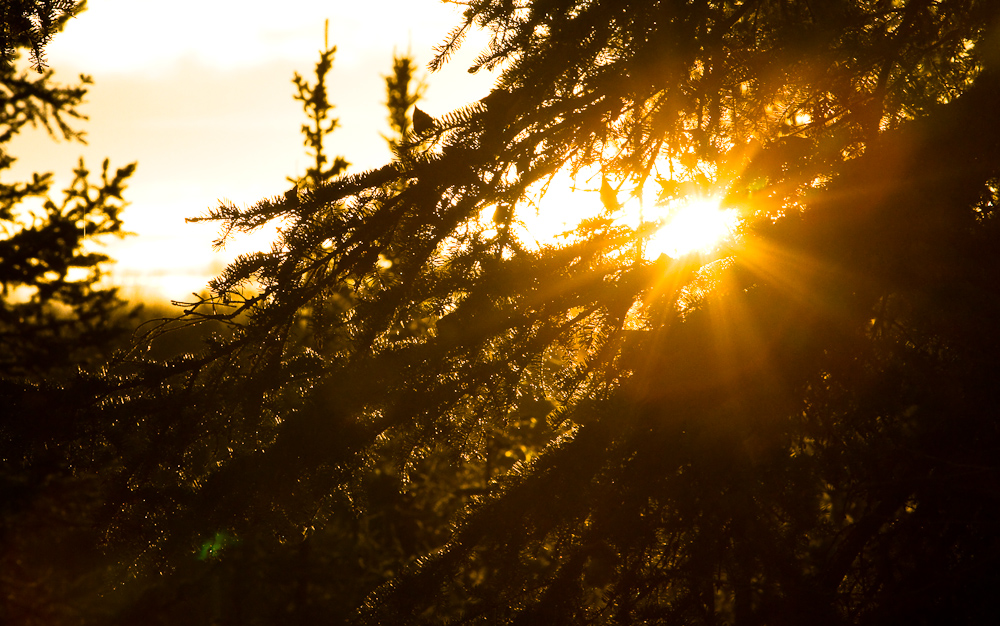
So a week or so ago, I promised you all some more detailed thoughts on Canon's new 7D. This is in no way a detailed technical review, there are more than enough sources on the internet to find that information if you want it. Rather, I'm going to give you some of my thoughts on the camera, how I think it handles, what I like and what I don't. Here it comes, beware the faint of heart:
1. First of all I like the look of the camera. From the XXD line it upgrades a bit on the design end. The sharp lines where the pop-up flash rises in the XXD series is smoothed in the 7D, emulating to some degree, the contours of Canon's professional grade cameras. It is perhaps a touch heavier than my 40D without the battery grip. I also very much like that Canon dispensed with the silly pre-set options on the dial (landscape, portrait, close-up etc.) I never used those, and nor should any serious photographer. It is nice to see them gone. I wish it came equipped with a vertical grip such as the 1D and 1Ds series but that, I realize, is asking too much in a mid-line camera. There are also substantial upgrades to the body material, full magnesium alloy which should make it substantially more durable than the XXD line and more equivalent to the 5D.
2. I LOVE the resolution on the screen. It is far and away better than the 40D. Great colors, and sharpness with enough detail to get a solid idea of the noise in an image. An excellent upgrade.
3. I even more love the fact that this camera can shoot full HD video. This opens up a world of possibilities for new creative endeavors, expanding my work into the realm of multi-media. I'm no expert in this regard so can't say how it compares to other cameras, but it is hard to imagine a better image, the files are huge, sharp and detailed. One nit is that I can't seem to get the camera to autofocus while shooting video, I may just not have the settings right, but this is something I need to explore more.
4. The autofocus is an improvement over the XXD line, but the user interface to select among the 18 sensors is a bit cumbersome. Again, maybe I just need to play with this, but so far, I'm only able to figure out how to select a focus point manually by clicking the select button then moving the multi-controller. On my 40D I only had to adjust the multi-controller which took less time. The autofocus does suffer from Canonitis. That being, it is a bit slow and unreliable in low-light conditions.
5. I love that the pop-up flash (otherwise useless) can be used as a commander for off-camera flash. With the click of a few menu selections I can separately control three groups of flashes. The camera seems to seamlessly communicate with both my old Canon 420EX and my new 580EX II. For general portrait and studio work, this saves the hassle and expense of dealing with Pocket Wizards.
6. Noise. This camera is 18+ megapixels in an APS-C sized sensor. That is PACKING them in there so I'm not surprised there is a bit of noise. Low ISOs (100-400 or even 800) are quite acceptable and require relatively little clean-up in Lightroom. However at 1600 and above it starts to get messy. I've gotten decent results at 1600 but that was starting to push it. With good noise reduction software on your side, or small reproduction sizes you might be able to go higher.
Well there you go. As you can see, in general, I like this camera a lot. It isn't perfect, the noise and auto-focus could be improved, but for the bucks, I think its the best camera on the market.
1. First of all I like the look of the camera. From the XXD line it upgrades a bit on the design end. The sharp lines where the pop-up flash rises in the XXD series is smoothed in the 7D, emulating to some degree, the contours of Canon's professional grade cameras. It is perhaps a touch heavier than my 40D without the battery grip. I also very much like that Canon dispensed with the silly pre-set options on the dial (landscape, portrait, close-up etc.) I never used those, and nor should any serious photographer. It is nice to see them gone. I wish it came equipped with a vertical grip such as the 1D and 1Ds series but that, I realize, is asking too much in a mid-line camera. There are also substantial upgrades to the body material, full magnesium alloy which should make it substantially more durable than the XXD line and more equivalent to the 5D.
2. I LOVE the resolution on the screen. It is far and away better than the 40D. Great colors, and sharpness with enough detail to get a solid idea of the noise in an image. An excellent upgrade.
3. I even more love the fact that this camera can shoot full HD video. This opens up a world of possibilities for new creative endeavors, expanding my work into the realm of multi-media. I'm no expert in this regard so can't say how it compares to other cameras, but it is hard to imagine a better image, the files are huge, sharp and detailed. One nit is that I can't seem to get the camera to autofocus while shooting video, I may just not have the settings right, but this is something I need to explore more.
4. The autofocus is an improvement over the XXD line, but the user interface to select among the 18 sensors is a bit cumbersome. Again, maybe I just need to play with this, but so far, I'm only able to figure out how to select a focus point manually by clicking the select button then moving the multi-controller. On my 40D I only had to adjust the multi-controller which took less time. The autofocus does suffer from Canonitis. That being, it is a bit slow and unreliable in low-light conditions.
5. I love that the pop-up flash (otherwise useless) can be used as a commander for off-camera flash. With the click of a few menu selections I can separately control three groups of flashes. The camera seems to seamlessly communicate with both my old Canon 420EX and my new 580EX II. For general portrait and studio work, this saves the hassle and expense of dealing with Pocket Wizards.
6. Noise. This camera is 18+ megapixels in an APS-C sized sensor. That is PACKING them in there so I'm not surprised there is a bit of noise. Low ISOs (100-400 or even 800) are quite acceptable and require relatively little clean-up in Lightroom. However at 1600 and above it starts to get messy. I've gotten decent results at 1600 but that was starting to push it. With good noise reduction software on your side, or small reproduction sizes you might be able to go higher.
Well there you go. As you can see, in general, I like this camera a lot. It isn't perfect, the noise and auto-focus could be improved, but for the bucks, I think its the best camera on the market.
Thursday, October 22, 2009
Ruffed Grouse, and stuff...
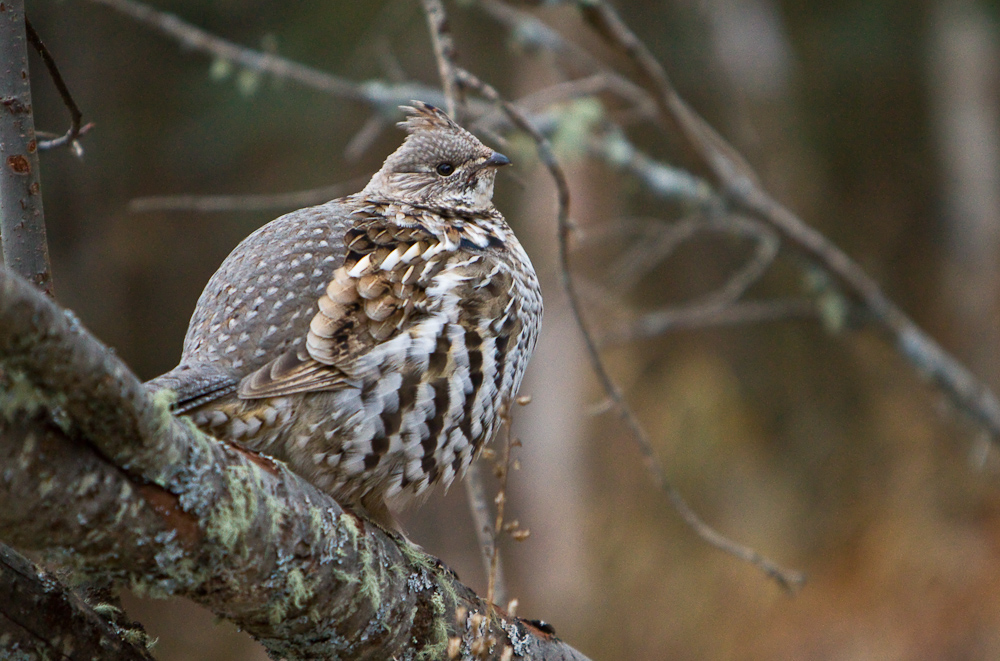
Canon 7D, 70-200f2.8L IS, f2.8, 1/200th second, ISO 1600, handheld.
This lovely Ruffed Grouse visited a tree just outside one of my cabin's windows day before yesterday. I had just a moment to snap an image or two before it wandered off into the woods. Which leads me to a thought:
Chase Jarvis the excellent commercial and lifestyle photographer and teacher, has a new book out called The Best Camera (is the one that's with you). It is a collection of his images shot from his iphone as well as some thoughts on opportunistic photography. I haven't read it, and probably won't for a while. Nothing against the book, I'm sure its great, but I've got a stack of photo books I'm working my way through and that one is way down at the bottom somewhere. However the POINT of the book is very clear- Have a camera with you. Always. The image above is representative of that. It seems like, much to my girlfriend's chagrin, that I always have a camera somewhere within arm's reach. Camera gear is scattered about our very small cabin, and it constantly gets in the way. But THIS is why. If I'd had to go digging for a camera, the grouse would have wandered off and I would have missed it entirely. But because I had my 7D sitting on a nearby chair, mounted with the 70-200, I got the image. No it isn't as good as it would have been had I had the chance to mount up the 500 on a tripod, but it's a perfectly acceptable image that I got because I was ready. So carry a camera. Always.
Chase Jarvis the excellent commercial and lifestyle photographer and teacher, has a new book out called The Best Camera (is the one that's with you). It is a collection of his images shot from his iphone as well as some thoughts on opportunistic photography. I haven't read it, and probably won't for a while. Nothing against the book, I'm sure its great, but I've got a stack of photo books I'm working my way through and that one is way down at the bottom somewhere. However the POINT of the book is very clear- Have a camera with you. Always. The image above is representative of that. It seems like, much to my girlfriend's chagrin, that I always have a camera somewhere within arm's reach. Camera gear is scattered about our very small cabin, and it constantly gets in the way. But THIS is why. If I'd had to go digging for a camera, the grouse would have wandered off and I would have missed it entirely. But because I had my 7D sitting on a nearby chair, mounted with the 70-200, I got the image. No it isn't as good as it would have been had I had the chance to mount up the 500 on a tripod, but it's a perfectly acceptable image that I got because I was ready. So carry a camera. Always.
Tuesday, October 20, 2009
Icy Sunset
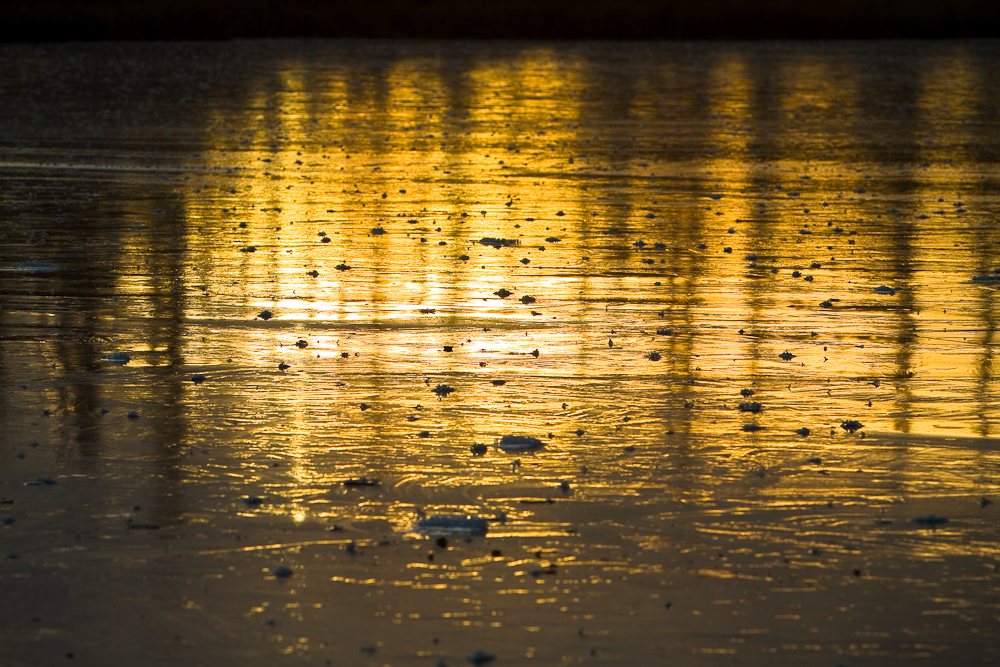
Canon 7D, 70-200f2.8L IS, 1/250th at f9.0, ISO 100
I'm afraid there is no denying it anymore, autumn is over, even if winter's snow has not yet arrived. There are people skating on the local ponds and talk has gone from admiring the indian summer to eager for snow. This time of year, as I noted a few days back, is also extremely good for photography. The morning and evening colors last forever, the stars are bright and fill the sky from horizon to horizon each cloudless night.
This image is of frozen Ballaine Pond on the University of Alaska Fairbanks campus. Crystals of frost were forming on top of the ice and that is why I stopped, but it wasn't the crystals that drew my attention, but the way the trees and fading sun reflected off the ice.
Monday, October 19, 2009
Different
Canon 7d, 70-200f2.8L IS, Handheld, 1/640th, f8.0, ISO 100
This is a rather atypical wildlife shot for me. It falls very much in to the "art" realm of my imagery. I've seen this kind of image (atypical framing and lighting, no distinct subject, but telling something of a story) fairly regularly in the fine art photography blogs and web sites. Most of my work falls into more classic structure. Yet I still kind of like this one. It's different, I don't feel like I've seen the image before, it tells a story and provides some scale. With increasing demand for atypical imagery, perhaps this kind of work has a future...On another topic entirely, I'm currently reading David duChemin's book "Within the Frame". It is an excellent read, not about the technology of photography, but about vision. There are a million books out there on how to operate a camera, how to expose, depth of field, and other very teachable subjects. However, there are VERY few books on how to see. "Within the Frame" is one, "The Inner Game of Outdoor Photography" by Galen Rowell is another. So is the "Tao of Photography" by Gross and Shapiro. Teaching how to see, teaching art, is extremely difficult but learning it is even harder. These writers provide some insight into their techniques. I highly recommend you read them all. Carefully. And over and over again.
Saturday, October 17, 2009
Flaming Birch
Canon 7D, 70-200f2.8L IS, 1/125th second @ f2.8, ISO 100, tripod mounted
Backlighted images like this can be tricky. Its impossible, and not even desirable in a situation like this to expose for all of it. I much prefer the glowing, almost cloudy appearance of this. Closer to how this looked in reality, and much, much closer to how the scene felt.
P.S. I figured how to make the images on here bigger. I think its a BIG improvement. I hope you agree.
Friday, October 16, 2009
The Last Days of Autmn
Since I acquired my Canon 7D last week I've been experimenting quite a bit with video, and mixture of video and stills. This is video, which I hope will become the first of a series, is the outcome of my initial experimentation. Enjoy. By the way, the music is by A.A. Bondy. He's great, you should really buy one of his albums.
Thursday, October 15, 2009
More Autumn
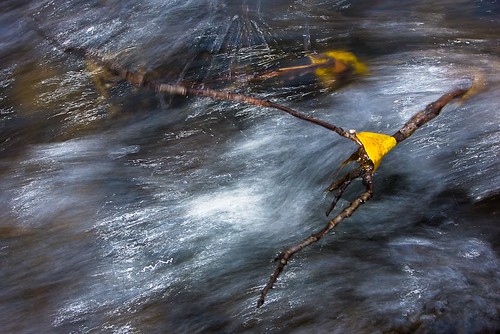
Canon 40d, 17-40 f4.0 L, @26mm
ISO 100, f11, 1/10th second, handheld.
(Trick to handheld sharpness- sit down low, brace elbows on knees,
and click the shutter as you exhale.)
Sunday, October 11, 2009
Last Leaves
This is the first processed image out of my brand spanking new, hot off the assembly-line, first-shipment Canon 7D. I'll do a review of my impressions of the camera at a later time, but I wanted to post this image that I made yesterday. Most of the leaves are now gone, but a few linger here and there, clinging delicately to their twigs. We've been graced by an incredible autumn, it was near 60 today, and I'm trying to relish every moment of it. Certainly, it can't last forever.
Wednesday, October 7, 2009
Revisiting Old Images
I often get so preoccupied with creating new images that I forget to go back and look at old ones. But, I'm currently preparing a collection of images from a trip the Arctic National Wildlife Refuge in the summer of 2007. It was a trip gifted with good light, amazing wildlife, and good people. These images are set to accompany an article I have forthcoming in Birder's World. I've been going back through the original RAW images, to reprocess the best in Lightroom. Better software and more advanced skills on my part have been led to much better completed images. The one above is perfect example. For whatever reason, I'm not even sure I've ever processed it before. And that is why it's a good idea to occasionally go back and take a look through your archives. You never know what you may find.
Subscribe to:
Posts (Atom)
